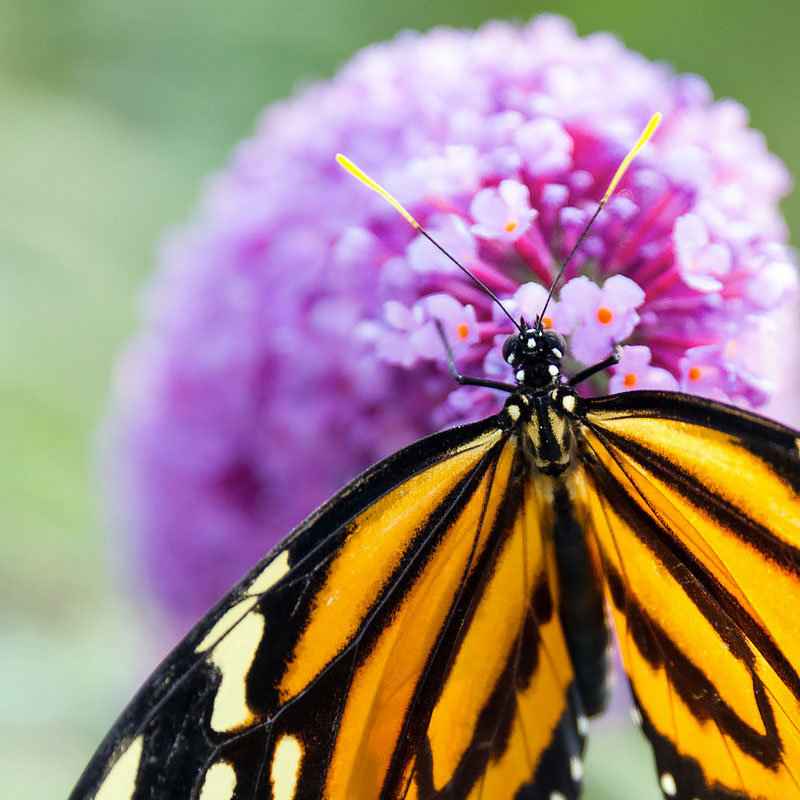

Smart Gardener
Gardening for Butterflies
It's butterfly season!

Butterflies are members of the insect order called Lepidoptera. There are about 2,000 types of moths and butterflies in Illinois. Of these, about 150 species are butterflies and 1,850 species are moths. Our local butterflies range from the tiny Eastern-tailed blue and gray hairstreak to the giant swallowtail. Butterflies and their offspring (eggs, caterpillars, and chrysalids) are food for many birds, mammals, and insects. They’re an important part of the overall ecological lifecycle.
Plants provide nectar and shelter for the eggs of butterflies and moths and food for caterpillars. The right plants can also help protect many of these winged wonders. For example, the majestic monarch butterflies are known for their incredible mass migration, flying up to 3,000 miles in late summer to their winter home in Mexico. But their numbers have greatly declined due to decreasing winter habitat, loss of native milkweed plants, predation, disease, unfavorable weather, insecticides, and many other factors.
You can help monarchs and other butterflies by planting a butterfly garden or containers that offer nectar for the adults and host plants for the caterpillars. Nectar is a sugar-rich liquid that butterflies, bees, and other pollinators rely on for energy. If you have flowers or herbs in your garden, you likely have nectar plants that will attract them.
Be a Butterfly Bartender

A butterfly’s tongue is shaped like a flexible straw, which it unrolls and dips into the base of a flower. Native perennials like bee balm (Monarda), purple coneflowers (Echinacea), and black-eyed Susan (Rudbeckia) are good sources of nectar, but many butterflies are also attracted to easy-to-grow annuals such as Mexican sunflower (Tithonia), zinnias, lantana, cosmos, ageratum, and verbena. Some butterflies visit mud puddles, damp soil, overripe fruit, tree sap, and carrion and animal feces to obtain salt and nutrients not found in nectar. A shallow dish filled with wet sand and a few pebbles can attract butterflies.
Host Plants
Most of the butterflies we see in summer live only a few weeks. During their short life, they must find food, avoid predators, seek shelter from bad weather, find a mate, and reproduce. On top of these daunting tasks, female butterflies must find suitable plants, called host plants, on which to lay their eggs.

Asclepias incarnata

Liatris

Asclepias tuberosa
Each species of butterfly requires specific plants on which to lay eggs. Monarchs, for example, will only lay eggs on milkweed (Asclepias). No other plant will do. Plant the colorful swamp milkweed (Asclepias incarnata), green milkweed (Asclepias viridis), and butterfly weed (Asclepias tuberosa). These well-behaved perennials do well in sunny flower beds and borders. Pair any of these plants with the violet-flowered prairie blazing star (Liatris), and you not only have a great plant combination, but you’ll feed monarchs and many other butterflies.
The elegant zebra swallowtail will only lay its eggs on the native, tropical-looking pawpaw tree (Asimina triloba). Although this small understory tree was once common in Illinois, its habitat has greatly diminished, which is a shame because the fruit, when ripe, is delicious.
Some hairstreaks lay their eggs on oaks, hickories, and butternut trees while the question mark butterfly lays eggs on the leaves of elm, hackberry, hop vines, and nettles. Although you may be alarmed by the thought of caterpillars chewing holes in leaves, the effect is usually minor and rarely noticed in the home landscape.
Life cycle

Monarch chrysalis, photo by Ellen Hodges

Swallowtail caterpillar, photo by Ellen Hodges
Depending on the butterfly species, females will lay a single egg, or eggs in rows or clusters, often on the underside of leaves. Once the eggs hatch, the caterpillars feed almost constantly. As they quickly grow, they shed their skins five or six times until the full-sized caterpillar crawls off to a sheltered spot, where it sheds its skin one last time. The new skin hardens to become a chrysalis (also called a pupa). The chrysalis stage may last a few weeks or as much as six months, depending on the species.
What happens next is extraordinary. Inside the chrysalis, the caterpillar’s tissues are liquefied and rearranged—a process called metamorphosis—as it transforms into a butterfly. When the adult butterfly is fully formed, the chrysalis skin splits and the butterfly emerges, hanging on to the shed skin while its wings expand. The newly emerged adult slowly pumps liquid into its wings to expand them, which takes about an hour. If the wings aren’t fully extended in this time, they may be deformed when they harden, preventing flight. If all goes well, the butterfly is soon ready to fly off in search of food, and a new generation begins again.
Nina Koziol is a garden writer and horticulturist who lives and gardens in Palos Park, Illinois.

